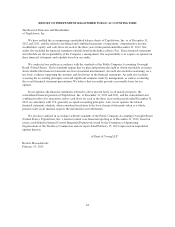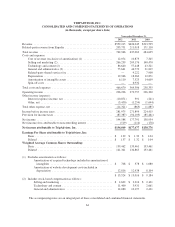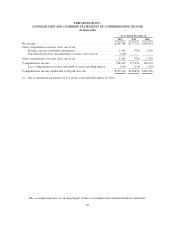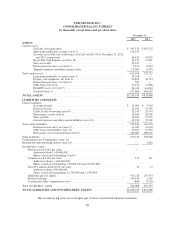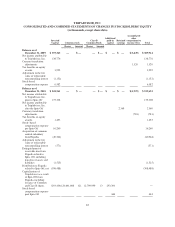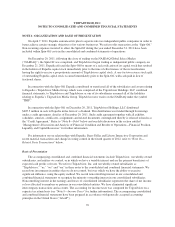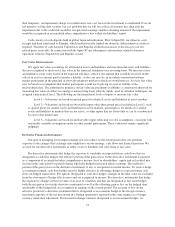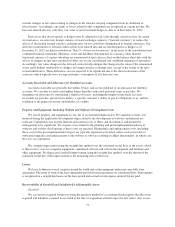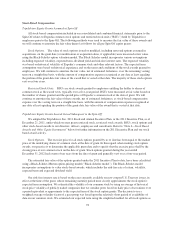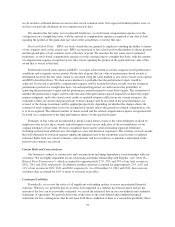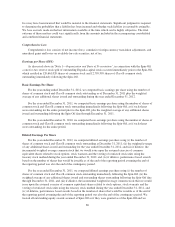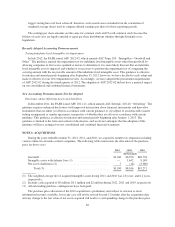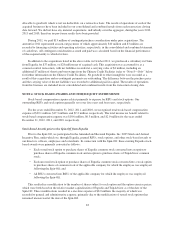TripAdvisor 2012 Annual Report Download - page 83
Download and view the complete annual report
Please find page 83 of the 2012 TripAdvisor annual report below. You can navigate through the pages in the report by either clicking on the pages listed below, or by using the keyword search tool below to find specific information within the annual report.Selling and Marketing
Sales and marketing expenses primarily consist of direct costs, including search engine marketing, or SEM,
other traffic acquisition costs, syndication costs and affiliate program commissions, brand advertising and public
relations. In addition, our indirect sales and marketing expense consists of personnel and overhead expenses,
including salaries, commissions, benefits, stock-based compensation expense and bonuses for sales, sales
support, customer support and marketing employees.
Technology and Content
Technology and content expenses consist of personnel and overhead expenses, including salaries and
benefits, stock-based compensation expense and bonuses for salaried employees and contractors engaged in the
design, development, testing and maintenance of our website. Other costs include licensing and maintenance
expense.
General and Administrative
General and administrative expenses consist primarily of personnel and related overhead costs, including
executive leadership, finance, legal and human resource functions and stock-based compensation as well as
professional service fees and other fees including audit, legal, tax and accounting, and other costs including bad
debt expense and our charitable foundation costs.
Cash, Cash Equivalents and Marketable Securities
Our cash equivalents consist of highly liquid investments with maturities of 90 days or less at the date of
purchase. Our marketable debt and equity securities have been classified and accounted for as available-for-sale.
We determine the appropriate classification of our investments at the time of purchase and reevaluate the
designations at each balance sheet date. We invest in highly-rated securities, and our investment policy limits the
amount of credit exposure to any one issuer, industry group and currency. The policy requires investments to be
investment grade, with the primary objective of minimizing the potential risk of principal loss and providing
liquidity of investments sufficient to meet our operating and capital spending requirements and debt repayments.
We classify our marketable debt securities as either short-term or long-term based on each instrument’s
underlying contractual maturity date and as to whether and when we intend to sell a particular security prior to its
maturity date. Marketable debt securities with maturities greater than 90 days at the date of purchase and
12 months or less remaining at the balance sheet date will be classified as short-term and marketable debt
securities with maturities greater than 12 months from the balance sheet date will generally be classified as long-
term. We classify our marketable equity securities, limited to money market funds and mutual funds, as either
short-term or long-term based on the nature of each security and its availability for use in current operations. Our
marketable debt and equity securities are carried at fair value, with the unrealized gains and losses, net of taxes,
reported in accumulated other comprehensive income (loss) as a component of shareholders’ equity. Fair values
are determined for each individual security in the investment portfolio.
Realized gains and losses on the sale of securities are determined by specific identification of each
security’s cost basis. We may sell certain of our marketable securities prior to their stated maturities for strategic
reasons including, but not limited to, anticipation of credit deterioration and liquidity and duration management.
The weighted average maturity of our total invested cash shall not exceed 12 months, and no security shall have a
final maturity date greater than three years.
When evaluating an investment for other-than-temporary impairment, we review factors such as the length
of time and extent to which fair value has been below its cost basis, the financial condition of the issuer and any
changes thereto, and our intent to sell, or whether it is more likely than not it will be required to sell the
investment before recovery of the investment’s cost basis. Once a decline in fair value is determined to be other
73


